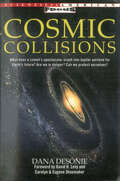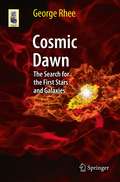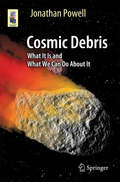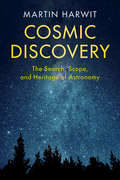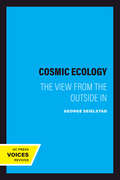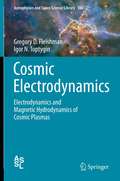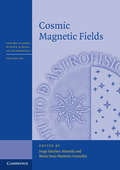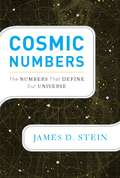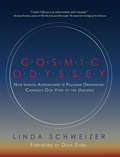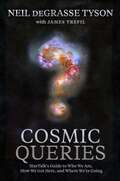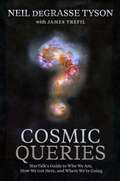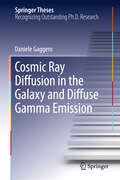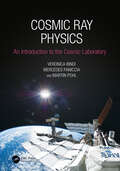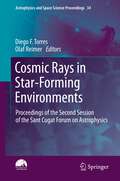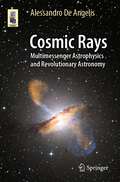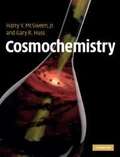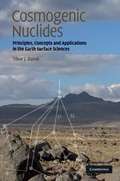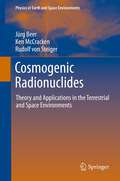- Table View
- List View
Cosmic Collisions
by Dana DesonieCosmic collisions have forever shaped the planets in our solar system, sculpting Earth and our Moon. They are still happening right in our neighborhood, as we saw in July 1994 when comet fragments bombarded the surface of Jupiter. What if a collision of that magnitude were to occur on Earth? Would the effect be anywhere near that of the collision that wiped out the dinosaurs 65 million years ago? Scientists have just begun to track distant asteroids and comets that may pose a threat to Earth in years to come. In Scientific American Focus: Cosmic Collisions Dana Desonie traces the history of cosmic collisions and proposes various solutions to what many view as our impending doom, answering these questions and more:-How often does Earth experience a cosmic collision?-Did a massive collision kill off the dinosaurs?-How do scientists track and predict collisions?-What did we learn from the Jupiter collision of 1994?-How real is the threat of a collision in our future?-How can we defend our planet?
Cosmic Conversations: Dialogues on the Nature of the Universe and the Search for Reality
by Stephan Martin&“Some of the most compelling, cutting-edge ideas about who we are and what kind of world we live in. This is a daring book—and a great read!&”—Glenn Hartelius, PhD, coeditor of the International Journal of Transpersonal Studies Have you ever looked up at the night sky and wondered &“What is the universe?&” In this lively and engaging collection of interviews, astronomer Stephan Martin talks with some of today&’s most innovative and cutting-edge thinkers on the nature of the universe and our relationship to it. Scientists, mystics, indigenous elders, and cultural creatives all share their unique voices on the nature of reality, the interplay of science and religion, the future of humanity, and the role of each person in a mysterious and evolving universe. Filled with rich insight, dynamic discussion, and penetrating wisdom, Cosmic Conversations asks the fundamental questions about the universe many of us have wondered about, yet few have explored in-depth, questions such as: Do time, space, and matter really exist? Can the universe be inside us, outside us, or both? Is the universe alive, conscious, and intelligent? Where are we in the cosmic evolutionary picture? A compelling journey from the farthest reaches of outer space to the innermost realms of the human heart, Cosmic Conversations will change the way you look at the universe (and yourself) forever. &“An excellent contribution to the philosophical revival that is taking place in the marketplace of ideas. Stephan&’s searching and heartfelt questions bring out the best of the authors he interviews.&”—Steve McIntosh, author of The Presence of the Infinite
Cosmic Dawn: The Search for the First Stars and Galaxies (Astronomers' Universe)
by George RheeThis book takes the reader on an exploration of the structure and evolution of our universe. The basis for our knowledge is the Big Bang theory of the expanding universe. This book then tells the story of our search for the first stars and galaxies using current and planned telescopes. These telescopes are marvels of technology far removed from Galileo's first telescope but continuing astronomy in his ground breaking spirit. We show the reader how these first stars and galaxies shaped the universe we see today. This story is one of the great scientific adventures of all time.
Cosmic Debris: What It Is and What We Can Do About It (Astronomers' Universe)
by Jonathan PowellThis book examines the mysterious and the well-studied debris in Earth's crowded neighborhood. From orbiting comets to the workings of the Asteroid Belt, and from meteor showers to our home-grown network of orbiting satellites, the full diversity of space objects and the debris they create is explored. Powell also discusses some of the current research techniques used to find potentially harmful rogue elements, with an emphasis on keeping watch for any objects that may intersect Earth's orbit. Such bodies also impact other worlds, and much has been learned from observing these encounters. The information in this book is intended to foster thought about the universe in which we live, but without overloading its readers with numbers and lecture-room analysis. Like a good thriller, it allows its readers to pace themselves with the story and, by the end, encourages them to draw their own conclusions.
Cosmic Discovery: The Search, Scope, and Heritage of Astronomy
by Martin HarwitMartin Harwit's influential book, Cosmic Discovery, is rereleased after more than thirty-five years, with a new preface written by the author. The work chronicles the astronomical discoveries up to the late twentieth century and draws conclusions that major discoveries have often been unexpected, unrelated to prevailing astronomical theories and made by outsiders from other fields. One trend alone seems to prevail: major discoveries follow major technological innovations in observational instruments. The author also examines discovery in terms of its political, financial, and sociological contexts including the role of industry and the military in enabling new technologies, and methods of funding. The challenges encountered by astronomy in the 1980s are remarkably similar to those astronomers face today. Difficulties persist in controlling recurrent cost overruns on planned missions, and in confronting mounting costs in developing observatories for detecting gravitational waves, high-energy cosmic rays, and particles that might explain dark matter.
Cosmic Ecology: The View from the Outside In
by George SeielstadThis title is part of UC Press's Voices Revived program, which commemorates University of California Press’s mission to seek out and cultivate the brightest minds and give them voice, reach, and impact. Drawing on a backlist dating to 1893, Voices Revived makes high-quality, peer-reviewed scholarship accessible once again using print-on-demand technology. This title was originally published in 1983.This title is part of UC Press's Voices Revived program, which commemorates University of California Press’s mission to seek out and cultivate the brightest minds and give them voice, reach, and impact. Drawing on a backlist dating to 1893, Voices Revived</DIV
Cosmic Electrodynamics: Electrodynamics and Magnetic Hydrodynamics of Cosmic Plasmas (Astrophysics and Space Science Library #388)
by Igor N. Toptygin Gregory D. FleishmanThis book presents the fundamental concepts of the theory, illustrated by numerous examples of astrophysical applications. Classical concepts are combined with new developments and the authors demarcate what is well established and what is still under debate. To book illustrates how apparently complicated phenomena can be addressed and understood using well-known physical principles and equations within appropriate approximations and simplifications. For this purpose, a number of astrophysical examples are considered in greater detail than what is normally presented in a regular textbook. In particular, a number of nonlinear self-consistent models are considered, which is motivated by the latest observational data and modern theory.
Cosmic Magnetic Fields (Cambridge Astrophysics Series)
by Philipp P. KronbergMagnetic fields are important in the Universe and their effects contain the key to many astrophysical phenomena that are otherwise impossible to understand. This book presents an up-to-date overview of this fast-growing topic and its interconnections to plasma processes, astroparticle physics, high energy astrophysics, and cosmic evolution. The phenomenology and impact of magnetic fields are described in diverse astrophysical contexts within the Universe, from galaxies to galaxy clusters, the filaments and voids of the intergalactic medium, and out to the largest redshifts. The presentation of mathematical formulae is accessible and is designed to add insight into the broad range of topics discussed. Written for graduate students and researchers in physics, astrophysics and related disciplines, this volume will inspire readers to devise new ways of thinking about magnetic fields in space on galaxy scales and beyond. Presents an up-to-date review of magnetic fields in the Galaxy and wider Universe, examining how they are measured and their interconnections to diverse astrophysical phenomena Discusses the techniques and methods for measuring magnetic fields, helping readers to appreciate future, more advanced magnetic field probes Presentation of mathematical formulae is accessible and designed to add insight into the broad range of topics discussed
Cosmic Magnetic Fields (Canary Islands Winter School of Astrophysics #25)
by Jorge Sánchez Almeida María Jesús Martínez GonzálezMagnetic fields pervade the universe and play an important role in many astrophysical processes. However, they require specialised observational tools, and are challenging to model and understand. <P><P>This volume provides a unified view of magnetic fields across astrophysical and cosmological contexts, drawing together disparate topics that are rarely covered together. Written by the lecturers of the XXV Canary Islands Winter School, it offers a self-contained introduction to cosmic magnetic fields on a range of scales. The connections between the behaviours of magnetic fields in these varying contexts are particularly emphasised, from the relatively small and close ranges of the Sun, planets and stars, to galaxies and clusters of galaxies, as well as on cosmological scales. Aimed at young researchers and graduate students, this up-to-date review uniquely brings together a subject often tackled by disconnected communities, conveying the latest advances as well as highlighting the limits of our current understanding.<P> Provides a unified view of the latest advances and the limits of our current understanding of cosmic magnetic fields.<P> Explores magnetic fields in a range of contexts, from the Sun, planets and stars, to galaxies and clusters of galaxies, as well as on cosmological scales.<P> The volume is complemented by online tutorials and slide shows of the lectures from the XXV Canary Islands Winter School.
Cosmic Messengers: The Limits of Astronomy in an Unruly Universe
by Martin HarwitMartin Harwit, author of the influential book Cosmic Discovery, asks key questions about the scope of observational astronomy. Humans have long sought to understand the world we inhabit. Recent realization of how our unruly Universe distorts information before it ever reaches us reveals distinct limits on how well we will ultimately understand the Cosmos. Even the best instruments we might conceive will inevitably be thwarted by ever more complex distortions and will never untangle the data completely. Observational astronomy, and the cost of pursuing it, will then have reached an inherent end. Only some totally different lines of approach, as yet unknown and potentially far more costly, might then need to emerge if we wish to learn more. This accessible book is written for all astronomers, astrophysicists, and those curious about how well we will ever understand the Universe and the potential costs of pushing those limits.
Cosmic Numbers: The Numbers That Define Our Universe
by James D. SteinStein (mathematics, California State U. ) recounts the stories of how famous mathematicians and physicists discovered numerical constants and equations that define the laws of physical science and astronomy. Appropriate for the general reader with a basic understanding of algebra, the 13 chapters explain the logic behind the speed of light, the ideal gas constant, absolute zero, Avogadro's number, the Planck constant, the Schwarzschild radius, and the Chandrasekhar limit. Annotation ©2011 Book News, Inc. , Portland, OR (booknews. com)
Cosmic Odyssey: How Intrepid Astronomers at Palomar Observatory Changed our View of the Universe
by Linda SchweizerHow pioneering scientists at Palomar Observatory make dazzling discoveries of astronomical phenomena beyond human experience and imagination.Ever since 1936, pioneering scientists at Palomar Observatory in Southern California have pushed against the boundaries of the known universe, making a series of dazzling discoveries that changed our view of the cosmos: quasars, colliding galaxies, supermassive black holes, brown dwarfs, supernovae, dark matter, the never-ending expansion of the universe, and much more. In Cosmic Odyssey, astronomer Linda Schweizer tells the story of the men and women at Palomar and their efforts to decipher the vast energies and mysterious processes that govern our universe.
Cosmic Origins: Science’s Long Quest to Understand How Our Universe Began
by M. Mitchell WaldropCosmic Origins tells the story of how physicists and astronomers have struggled for more than a century to understand the beginnings of our universe, from its origins in the Big Bang to the modern day. The book will introduce the science as a narrative, by telling the story of the scientists who made each major discovery. It will also address and explain aspects of our theories that some cosmologists are still hesitant to accept, as well as gaps in our knowledge and even apparent inconsistencies in our measurements. Clearly written by a master of scientific exposition, this book will fascinate the curious general reader as well as providing essential background reading for college-level courses on physics and astronomy.
Cosmic Queries: StarTalk's Guide to Who We Are, How We Got Here, and Where We're Going
by James Trefil Neil deGrasse TysonIn this thought-provoking follow-up to his acclaimed StarTalk book, uber astrophysicist Neil deGrasse Tyson tackles the world's most important philosophical questions about the universe with wit, wisdom, and cutting-edge science. For science geeks, space and physics nerds, and all who want to understand their place in the universe, this enlightening new book from Neil deGrasse Tyson offers a unique take on the mysteries and curiosities of the cosmos, building on rich material from his beloved StarTalk podcast. In these illuminating pages, illustrated with dazzling photos and revealing graphics, Tyson and co-author James Trefil, a renowned physicist and science popularizer, take on the big questions that humanity has been posing for millennia--How did life begin? What is our place in the universe? Are we alone?--and provide answers based on the most current data, observations, and theories. Populated with paradigm-shifting discoveries that help explain the building blocks of astrophysics, this relatable and entertaining book will engage and inspire readers of all ages, bring sophisticated concepts within reach, and offer a window into the complexities of the cosmos.
Cosmic Queries: Startalk's Guide to Who We Are, How We Got Here, and Where We're Going
by James Trefil Neil DeGrasse Tyson"An exploration of some of the deepest questions about our place in the universe"
Cosmic Ray Diffusion in the Galaxy and Diffuse Gamma Emission (Springer Theses)
by Daniele GaggeroThe original work presented in this thesis constitutes an important contribution to modern Cosmic Ray (CR) physics, and comes during one of the most exciting periods of this field. The first part introduces a new numerical code (DRAGON) to model the CR propagation in our Galaxy. The code is then used to perform a combined analysis of CR data, making it possible to determine their propagation properties with unprecedented accuracy. The second part is dedicated to a theoretical interpretation of the recent crucial experimental results on cosmic electron and positron spectra (PAMELA, Fermi-LAT experiments). Using the tools developed in the first part of the thesis, the author convincingly argues for the existence of a new spectral component, which could arise either from local astrophysical sources, such as pulsars, or from Dark Matter annihilation or decay. This thesis is a highly advanced work; the methods, analysis and results are clearly and carefully presented. This work is set to become an important reference document for any future work in this area.
Cosmic Ray Neutron Sensing: Estimation of Agricultural Crop Biomass Water Equivalent
by Ammar Wahbi Lee Heng Gerd DerconThis open access book provides methods for the estimation of Biomass Water Equivalent (BEW), an essential step for improving the accuracy of area-wide soil moisture by cosmic-ray neutron sensors (CRNS). Three techniques are explained in detail: (i) traditional in-situ destructive sampling, (ii) satellite based remote sensing of plant surfaces, and (iii) biomass estimation via the use of the CRNS itself. The advantages and disadvantages of each method are discussed along with step by step instructions on proper procedures and implementation.
Cosmic Ray Physics: An Introduction to The Cosmic Laboratory
by Martin Pohl Veronica Bindi Mercedes PanicciaThis book introduces you to the physics of cosmic rays, charged particles which reach us from known – and maybe unknown – sources in the cosmos. Starting from a brief history of this fascinating field, it reviews what we know about the creation of elements in the Big Bang and inside stars. It explains cosmic accelerators reaching fabulous energies. It follows the life cycle of cosmic rays all the way from their sources to detection near, on or below Earth. The central three chapters cover what we know about them at the level of the solar system, the Milky Way and the Universe at large. Up-to-date experimental results are presented in detail, showing how they are obtained and interpreted. The book provides an accessible overview of this lively and diversified research field. It will be of interest to undergraduate physics students beginning their studies on astronomy, cosmology, and particle physics. It is also accessible to the general public by concentrating mathematical and technical detail into Focus Boxes. Key features: Complete introductory overview of cosmic ray physics Covers the origins, acceleration, transport mechanisms and detection of these particles Mathematical and technical detail is kept separate from the main text
Cosmic Rays And Particle Physics
by Thomas K. Gaisser Ralph Engel Elisa ResconiFully updated for the second edition, this book introduces the growing and dynamic field of particle astrophysics. It provides an overview of high-energy nuclei, photons and neutrinos, including their origins, their propagation in the cosmos, their detection on Earth and their relation to each other. Coverage is expanded to include new content on high energy physics, the propagation of protons and nuclei in cosmic background radiation, neutrino astronomy, high-energy and ultra-high-energy cosmic rays, sources and acceleration mechanisms, and atmospheric muons and neutrinos. Readers are able to master the fundamentals of particle astrophysics within the context of the most recent developments in the field. This book will benefit graduate students and established researchers alike, equipping them with the knowledge and tools needed to design and interpret their own experiments and, ultimately, to address a number of questions concerning the nature and origins of cosmic particles that have arisen in recent research.
Cosmic Rays in Star-Forming Environments: Proceedings of the Second Session of the Sant Cugat Forum on Astrophysics (Astrophysics and Space Science Proceedings #34)
by Diego F. Torres Olaf ReimerThese are the proceedings of the Sant Cugat Forum 2nd Workshop on Cosmic-ray Induced Phenomenology in Stellar Environments, held April 16-19, 2012. The aim of this Workshop was to address the current knowledge and challenges of high-energy emission from stellar environments at all scales and provide a comprehensive review of the state of the field from the observational to the theoretical perspectives. In the meeting, the prospects for possible observations with planned instruments across the multi-wavelength spectrum were analyzed and also how they impact on our understanding of these systems.
Cosmic Rays: Multimessenger Astrophysics and Revolutionary Astronomy (Astronomers' Universe)
by Alessandro De AngelisIn recent years, cosmic rays have become the protagonists of a new scientific revolution. We are able today to film the Universe with telescopes of completely novel conception, recording information from many different messengers and accessing previously unknown cosmic regions.Written by a recognized authority in physics, this book takes readers on a captivating journey through the world of cosmic rays, their role in the revolutionary field of multi-messenger astronomy, their production from powerful accelerators close to the surfaces of black holes and compact objects, reaching the highest levels of energy observed in nature, and the implications this has for our understanding of the Universe. Through the stories of pioneering scientists, explorations of cutting-edge technologies, and simple explanations related to particle physics, quantum mechanics, and astrophysics, the book provides an illuminating state-of-the-art introduction to the current state of high-energy astrophysics. The book was written in straightforward yet rigorous language, so as to be accessible to the greater public. For those curious about the cosmos and cosmic gamma rays, nuclei, neutrinos, and gravitational waves, from casual observers to professional astronomers and physicists, the book is a must-read, offering a thrilling adventure into the future of astronomy and particle physics.
Cosmochemistry
by Gary R. Huss Harry Y. Mcsween Jr.How did the Solar System's chemical composition evolve? This textbook provides the answers in the first interdisciplinary introduction to cosmochemistry. It makes this exciting and evolving field accessible to undergraduate and graduate students from a range of backgrounds, including geology, chemistry, astronomy and physics. The authors - two established leaders who have pioneered developments in the field - provide a complete background to cosmochemical processes and discoveries, enabling students outside geochemistry to understand and explore the Solar System's composition. Topics covered include: - synthesis of nuclides in stars - partitioning of elements between solids, liquids and gas in the solar nebula - overviews of the chemistry of extraterrestrial materials - isotopic tools used to investigate processes such as planet accretion and element fractionation - chronology of the early Solar System - geochemical exploration of planets Boxes provide basic definitions and mini-courses in mineralogy, organic chemistry, and other essential background information for students. Review questions and additional reading for each chapter encourage students to explore cosmochemistry further.
Cosmogenesis: An Unveiling of the Expanding Universe
by Brian Thomas SwimmeFrom the host and cocreator of PBS&’s Journey of the Universe, a fresh look at how the rich collision between science and spirituality has influenced contemporary consciousness The understanding that the universe has been expanding since its fiery beginning 14 billion years ago and has developed into stars, galaxies, life, and human consciousness is one of the most significant in human history. It is taught throughout the world and has become our common creation story for nearly every culture. In terms of the universe&’s development, we humans are not only economic, religious, or political beings. At the most fundamental level, we are cosmological beings. Cosmogenesis is one of the greatest discoveries in human history, and it continues to have a profound impact on humanity. And yet most science books do not explore the effects it has had on our individual minds. In Cosmogenesis, Brian Thomas Swimme narrates the same cosmological events that we agree are fact but offers a feature unlike all other writings on this topic. He tells the story of the universe while simultaneously telling the story of the storyteller. Swimme describes how the impact of this new story deconstructed his mind then reassembled it, offering us a glimpse into how cosmogenesis has transformed our understanding of both the universe and the evolution of human consciousness itself.
Cosmogenic Nuclides
by Tibor J. DunaiThis is the first book to provide a comprehensive and state-of-the-art introduction to the novel and fast-evolving topic of in-situ produced cosmogenic nuclides. It presents an accessible introduction to the theoretical foundations, with explanations of relevant concepts starting at a basic level and building in sophistication. It incorporates, and draws on, methodological discussions and advances achieved within the international CRONUS (Cosmic-Ray Produced Nuclide Systematics) networks. Practical aspects such as sampling, analytical methods and data-interpretation are discussed in detail and an essential sampling checklist is provided. The full range of cosmogenic isotopes is covered and a wide spectrum of in-situ applications are described and illustrated with specific and generic examples of exposure dating, burial dating, erosion and uplift rates and process model verification. Graduate students and experienced practitioners will find this book a vital source of information on the background concepts and practical applications in geomorphology, geography, soil-science, and geology.
Cosmogenic Radionuclides: Theory and Applications in the Terrestrial and Space Environments (Physics of Earth and Space Environments)
by Jürg Beer Ken Mccracken Rudolf Von SteigerCosmogenic radionuclides are radioactive isotopes which are produced by natural processes and distributed within the Earth system. With a holistic view of the environment the authors show in this book how cosmogenic radionuclides can be used to trace and to reconstruct the history of a large variety of processes. They discuss the way in which cosmogenic radionuclides can assist in the quantification of complex processes in the present-day environment. The book aims to demonstrate to the reader the strength of analytic tools based on cosmogenic radionuclides, their contribution to almost any field of modern science, and how these tools may assist in the solution of many present and future problems that we face here on Earth. The book provides a comprehensive discussion of the basic principles behind the applications of cosmogenic (and other) radionuclides as environmental tracers and dating tools. The second section of the book discusses in some detail the production of radionuclides by cosmic radiation, their transport and distribution in the atmosphere and the hydrosphere, their storage in natural archives, and how they are measured. The third section of the book presents a number of examples selected to illustrate typical tracer and dating applications in a number of different spheres (atmosphere, hydrosphere, geosphere, biosphere, solar physics and astronomy). At the same time the authors have outlined the limitations of the use of cosmogenic radionuclides. Written on a level understandable by graduate students without specialist skills in physics or mathematics, the book addresses a wide audience, ranging from archaeology, biophysics, and geophysics, to atmospheric physics, hydrology, astrophysics and space science.
